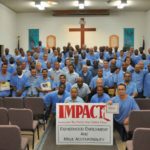About 150 men gathered at San Quentin’s Protestant Chapel to praise dozens of graduates of a prosocial program designed to teach empathy, … [Read more...]
Archives for October 2013
Mark Jackson’s Celebrity Team Tops the S.Q. Warriors, 134-119
Mark Jackson, head coach of the Golden State Warriors, returned to San Quentin with ex-NBA champion, Brian Scalabrine, Warriors General Manager Bob … [Read more...]
‘Justice Reinvestment’ Gets Billions for Reform
A reform movement is taking hold in the country. It’s called “justice reinvestment,” and it aims to harvest the billions spent on incarceration and … [Read more...]
2 Studies Help CDCR Judge Inmate Risk Level
The California Department of Corrections and Rehabilitation (CDCR) is using one of two studies on crime, incarceration, and recidivism as management … [Read more...]
Ex-Convicts Will Soon Qualify for ObamaCare
Beginning January 2014, the 10,000 plus ex-convicts released from California prisons monthly will be eligible to receive health care through the … [Read more...]
Some Prisoners Still Wait on Prop. 36
Numerous San Quentin inmates are still waiting for their day in court nearly a year after voters agreed that the nation’s toughest recidivist law … [Read more...]
John Curzon Becomes New Acting Chief Deputy Warden
John Curzon takes his 26 years of experience with the California Department of Corrections and Rehabilitation to greater heights as San Quentin’s new … [Read more...]
Richmond Project Promoting Non-Violence
Dozens of local residents gathered at Richmond’s Civic Center Plaza to watch a short documentary produced by incarcerated men to promote nonviolence … [Read more...]
Taking Aim to Stop Childhood Violence
There is a new effort to prevent childhood violence, and address the needs of America’s youngest victims according to a report by Dr. Nadine Burke … [Read more...]
Study Shows Summer Jobs Curb Violence By Teenagers
Research indicates summer jobs for youths help to reduce violence and reckless behavior such as alcohol, drug use, and other misconduct. “Teenagers … [Read more...]
- 1
- 2
- 3
- 4
- Next Page »



